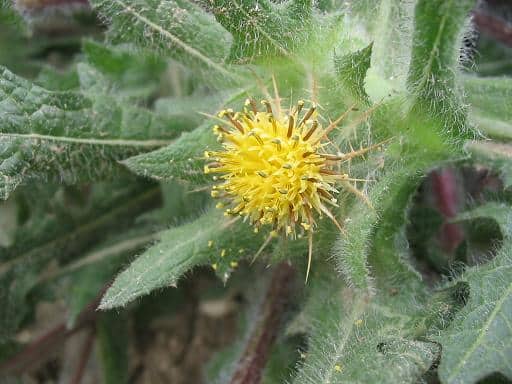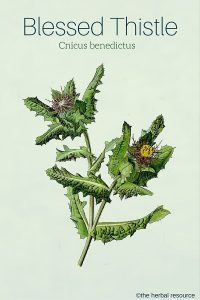Botanical Name: Cnicus benedictus L, Centaurea benedicta.
Other Common Names: Holy thistle, sacred thistle, St. Benedicts thistle, spotted thistle, blessed cardus, lady’s thistle, cardin, karbenedikt (Swedish), benediktenkraut (German), cardo santo (Spanish), Chardon bénit (French), heilagur þistill (Icelandic).
Habitat: This plant is native to the Mediterranean countries and Southeast Asia.
Today, it is found both growing wild and cultivated in Central Europe, the southern United States and parts of Central and South America.
Description: Blessed thistle is an annual hairy plant that can grow up to 70 cm in height. It has a branchy pentagonal stalk, and the leaves are lanceolate with a spiny edge.
The numerous flowers are yellow and are arranged in a crown at the tip of the stem. The plant blooms from May to August.
Plant Parts Used: All of the above-ground parts of the herb are used in herbal medicine.

Therapeutic Uses, Benefits and Claims of Blessed Thistle
Blessed thistle contains lignans, essential oil, tannins, and the minerals calcium, potassium, iron, magnesium and manganese. The main bitter substance is cnicin present in a concentration of 0.2 to 0.7 percent.
In Greek folk medicine the herb was used to treat malaria, and the common belief was it could cure epidemic diseases such as measles, chickenpox, smallpox, and plague.
The herb is often used in the form of herbal teas as an herbal remedy for loss of appetite, indigestion (which is not related to ulcers), respiratory ailments, intestinal worms, constipation, flatulence, colic, anorexia and ailments associated with poor liver function like headache, fatigue and irritability.
The bitter substance found in blessed thistle is what makes the herb stimulate the appetite and enhance digestion through increased secretion of juices from the salivary glands, stomach, pancreas, gallbladder, and bowels.
The astringent (constricting) properties of the plant makes it a good remedy for treating diarrhea. When used to treat diarrhea, it is often combined with other herbs with high tannin content like agrimony (Agrimonia eupatoria), meadowsweet (Filipendula ulmaria) and tormentil (Potentilla erecta).
Blessed thistle has antibiotic properties due to the substance cnicin, the essential oil and the polyacetylene found in the plant.
It may be used to help stimulate the immune system
The herb also has diuretic properties that may prove useful for high fever and feverish conditions.
The herb can act as an expectorant and may be used for respiratory infections such as colds and flu.
It has been used against Staphylococcus aureus and Escherichia coli due to the germicidal properties of the plant. The herb also contains substances that have been reported to prevent HIV.
Blessed thistle has been used traditionally to treat some symptoms of menopause, to relieve painful menstruation, menstrual cramps and menstrual headaches and also for increasing milk production in lactating mothers.
It is thought to increase blood circulation to the brain and is used traditionally to improve memory and concentration and to relieve headaches (especially if related to poor liver function) and depression.
In the past blessed thistle was a popular remedy for arthritis, gout, rheumatism and healing and cleaning wounds.
Additionally, it was used to treat chilblains, a foot condition, and shingles.
The young fresh leaves of blessed thistle may be added to salads, and the young flower heads can be eaten in the same way as artichoke (Cynara scolymus), which is related to the plant.
The root can be boiled and eaten as a vegetable. Blessed thistle is also used to make bitter liqueurs and was formerly used in beer brewing.
Dosage and Administration
As a tea: Pour two cups boiling water over 1.5 to 2 g of the dried herb and simmer for 5 to 10 minutes. Take it up to three times daily, preferably just before meals. The recommended total daily dose of the dried herb is 4.6 g.
As a tincture: Use liquid extract of blessed thistle (1:1 in 25 percent alcohol) in doses of 1 to 3 ml, or 3 to 6 ml of a strong tincture (1:4 in 25 percent alcohol).
Side Effects and Interactions of Blessed Thistle
There have been no reports of side effects or contraindications when blessed thistle is used properly.
Pregnant women and people with stomach ulcers should avoid the herb.
As with other bitter herbs blessed thistle taken at higher than recommended doses may cause irritation to the gastrointestinal tract that can lead to nausea, vomiting or diarrhea.
There is also a theoretical possibility that the herb can cause allergic reactions in people who are hypersensitive to other plants in the Asteraceae family (commonly referred to as the aster, daisy or sunflower family).
This includes plants like Arnica montana, chamomile, tansy and yarrow. Such allergic reactions are apparently very rare but can occur.
Supporting References
Wood, Matthew: The Earthwise Herbal. Berkeley, California. North Atlantic Books 2008
Williamson, Elisabeth M.: Potter’s Herbal Cyclopaedia. Essex, England. Saffron Walden 2003.
Volák, Jan & Jiri Stodola: The Illustrated Book of Herbs. London. Caxton Editions 1998.
van Wyk, Ben-Erik & Michael Wink: Medicinal Plants of the World. Portland, Oregon, Timber Press 2004.
Skenderi, Gazmend: Herbal Vade Mecum. 800 Herbs, Spices, Essential Oils, Lipids Etc. Constituents, Properities, Uses, and Caution. Rutherford, New Jersey, Herbacy Press 2003.
Mars, Brigitte: The Desktop Guide to Herbal Medicine. Laguna Beach, California. Basic Healh Publications, Inc. 2007.
Gruenwald, Joerg et al.: PDR for Herbal Medicines. 4th Ed. Montvale, New Jersey, Thomson Healthcare Inc. 2007.
Bown, Deni: The Royal Horticultural Society New Encyclopedia of Herbs & Their Uses. London. Dorling Kindersley 2002.
Barnes, Joanne; Linda A. Anderson & J. David Phillipson: Herbal Medicines: A Fuide for Healthcare Professionals.2nd Ed. London. Pharmaceutical Press 2002.
Barker, Julian: The Medicinal Flora of Britain & Northwestern Europe. Kent, England. Winter Press 2001.
Thordur Sturluson
Latest posts by Thordur Sturluson (see all)
- What is the Difference Between Hemp and Marijuana? - June 3, 2019

Leave a Reply